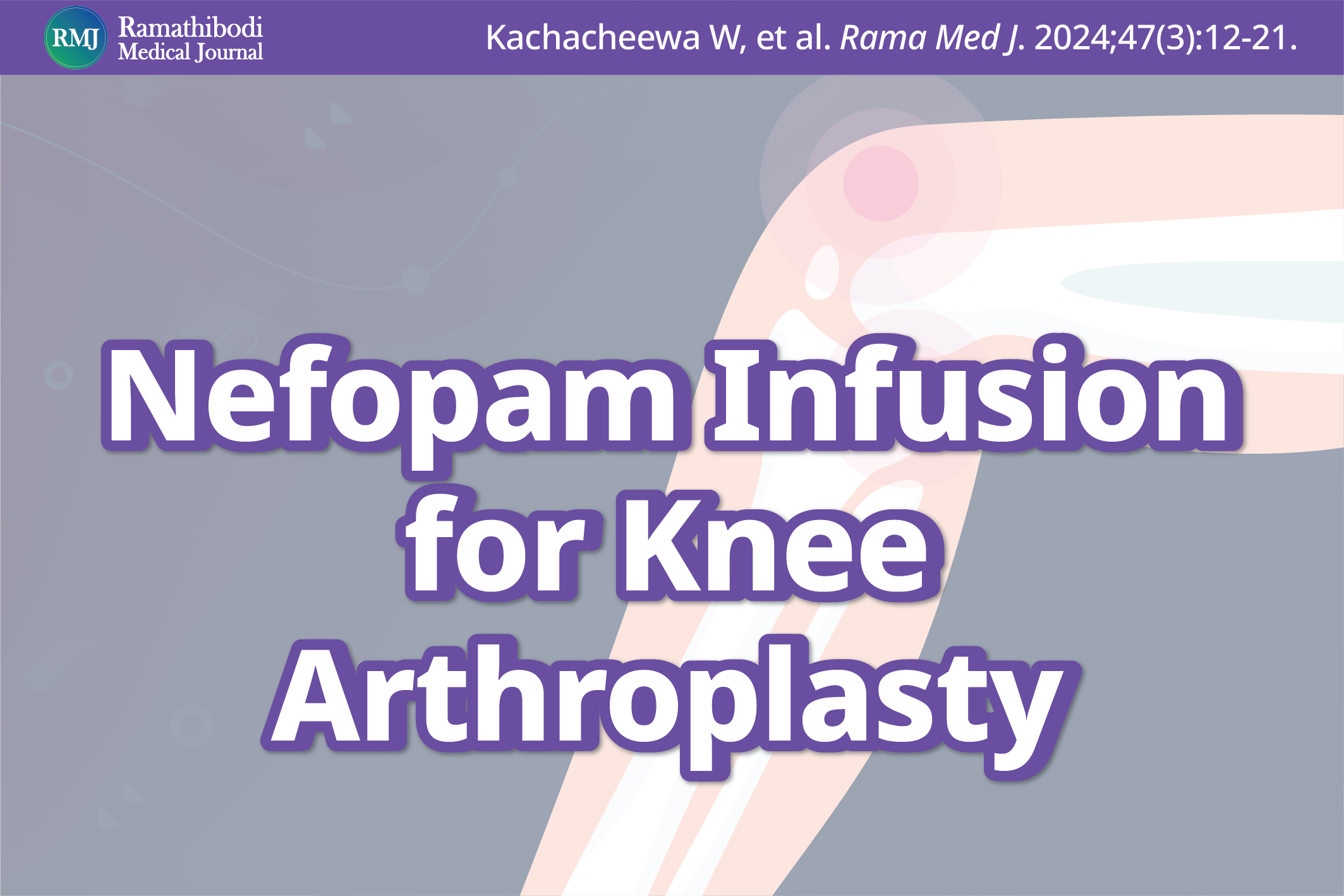Morphine-Sparing Effect of Intermittent Versus Continuous Intravenous Infusion of Nefopam in Patients After Total Knee Arthroplasty: A Randomized Trial
DOI:
https://doi.org/10.33165/rmj.2024.47.3.268540Keywords:
Nefopam, Morphine-sparing effect, Total knee arthroplasty, Intravenous infusion, Multimodal analgesiaAbstract
Background: Nefopam, a nonopioid analgesic, is recommended to improve pain control and minimize opioid-related side effects following total knee arthroplasty (TKA).
Objective: To compare cumulative morphine consumption between intermittent infusion (II) and continuous infusion (CI) of nefopam, combined with other multimodal analgesics, in TKA patients.
Methods: Fifty-eight patients were randomly assigned to receive either intermittent nefopam infusion (II group) (20 mg IV every 6 hours) or continuous infusion (CI group) (80 mg/day). The primary outcome was cumulative morphine consumption via patient-controlled analgesia, with secondary outcomes including pain scores every 4 hours and adverse drug reactions (ADRs).
Results: No significant difference was found in cumulative morphine consumption (median [range], 4 [0 -12] mg in II and 6 [0 - 18] mg in CI; P = .579) and the ADRs over 48 hours between groups. At 4 hours, the II group had significantly lower pain scores compared to the CI group (median [range], 0 [0 - 4] and 0 [0 - 8]; P = .008). However, by 24 and 36 hours, the CI group reported significantly lower pain scores compared to the II group; median (range), 0 (0 - 5) vs 2 (0 - 9) at 24 hours (P = .020) and 0 (0 - 4) vs 2 (0 - 8) at 36 hours (P = .014).
Conclusions: Both intermittent and continuous nefopam infusion in primary TKA showed no significant difference in morphine-sparing or occurrence of ADRs within the 48-hour follow-up period. These findings suggest that both infusion methods are comparable in managing post-operative pain in TKA patients.
References
Ferguson RJ, Palmer AJ, Taylor A, Porter ML, Malchau H, Glyn-Jones S. Hip replacement. Lancet. 2018;392(10158):1662-1671. doi:10.1016/S0140-6736(18)31777-X
Price AJ, Alvand A, Troelsen A, et al. Knee replacement. Lancet. 2018;392(10158):1672-1682. doi:10.1016/S0140-6736(18)32344-4
Grosu I, Lavand’homme P, Thienpont E. Pain after knee arthroplasty: an unresolved issue. Knee Surg Sports Traumatol Arthrosc. 2014;22(8):1744-1758. doi:10.1007/s00167-013-2750-2
De Luca ML, Ciccarello M, Martorana M, et al. Pain monitoring and management in a rehabilitation setting after total joint replacement. Medicine (Baltimore). 2018;97(40):e12484. doi:10.1097/MD.0000000000012484
Lavand’homme PM, Kehlet H, Rawal N, Joshi GP; PROSPECT Working Group of the European Society of Regional Anaesthesia and Pain Therapy (ESRA). Pain management after total knee arthroplasty: PROcedure SPEcific Postoperative Pain ManagemenT recommendations. Eur J Anaesthesiol. 2022;39(9):743-757. doi:10.1097/EJA.0000000000001691
Aveline C, Gautier JF, Vautier P, et al. Postoperative analgesia and early rehabilitation after total knee replacement: a comparison of continuous low-dose intravenous ketamine versus nefopam. Eur J Pain. 2009;13(6):613-619. doi:10.1016/j.ejpain.2008.08.003
Pinsornsak P, Sukkarnkosol S, Boontanapibul K. Does nefopam provide analgesic effect and reduce morphine consumption after primary total knee arthroplasty? a prospective, double-blind, randomized controlled trial. J Arthroplasty. 2022;37(5):845-850. doi:10.1016/j.arth.2022.01.079
Kim KH, Abdi S. Rediscovery of nefopam for the treatment of neuropathic pain. Korean J Pain. 2014;27(2):103-111. doi:10.3344/kjp.2014.27.2.103
Choi E, Karm MH, So E, et al. Effects on postoperative nausea and vomiting of nefopam versus fentanyl following bimaxillary orthognathic surgery: a prospective double-blind randomized controlled trial. J Dent Anesth Pain Med. 2019;19(1):55-66. doi:10.17245/jdapm.2019.19.1.55
Evans MS, Lysakowski C, Tramèr MR. Nefopam for the prevention of postoperative pain: quantitative systematic review. Br J Anaesth. 2008;101(5):610-617. doi:10.1093/bja/aen267
Du Manoir B, Aubrun F, Langlois M, et al. Randomized prospective study of the analgesic effect of nefopam after orthopaedic surgery. Br J Anaesth. 2003;91(6):836-841. doi:10.1093/bja/aeg264
Mimoz O, Incagnoli P, Josse C, et al. Analgesic efficacy and safety of nefopam vs propacetamol following hepatic resection. Anaesthesia. 2001;56(6):520-525. doi:10.1046/j.1365-2044.2001.01980.x
Tramoni G, Viale JP, Cazals C, Bhageerutty K. Morphine-sparing effect of nefopam by continuous intravenous injection after abdominal surgery by laparotomy. Eur J Anaesthesiol. 2003;20(12):990-992. doi:10.1017/s0265021503251590
Merle JC, Vandroux D, Odin I, et al. Analgesic effect of continuous intravenous nefopam after urological surgery. Ann Fr Anesth Reanim. 2005;24(1):13-18. doi:10.1016/j.annfar.2004.11.008
Chambers DJ. Principles of intravenous drug infusion. Anaesth Intensive Care Med. 2019;20(1):61-64. doi:10.1016/j.mpaic.2018.11.005
Pai V, Knipe H, Rock P, et al. Kellgren and Lawrence system for classification of osteoarthritis. Update April 20, 2024. Accessed July 14, 2024. https://radiopaedia.org/articles/27111
Faul F, Erdfelder E, Lang AG, Buchner A. G*Power 3: a flexible statistical power analysis program for the social, behavioral, and biomedical sciences. Behav Res Methods. 2007;39(2):175-191. doi:10.3758/bf03193146
Ahmad M, Yaqoob M, Murtaza G. Study of pharmacokinetics and comparative bioavailability of nefopam 30 mg tablets in twelve fasting healthy Pakistani male young subjects: single-dose, randomized, two-period, two-treatment and two-way cross-over design. Med Princ Pract. 2012;21(3):271-276. doi:10.1159/000333560
Kim JY, Kim JH, Yee J, Song SJ, Gwak HS. Risk factors of opioid-induced adverse reactions in elderly male outpatients of Korea Veterans Hospital. BMC Geriatr. 2018;18(1):293. doi:10.1186/s12877-018-0990-1
Dagostino C, Allegri M, Napolioni V, et al. CYP2D6 genotype can help to predict effectiveness and safety during opioid treatment for chronic low back pain: results from a retrospective study in an Italian cohort. Pharmgenomics Pers Med. 2018;11:179-191. doi:10.2147/PGPM.S181334
Rattana-arpa S, Sriswasdi P. Pharmacogenomics: new challenges for Thai anesthesiologists. J Med Assoc Thail. 2017;100(suppl 7):250-258.

Downloads
Published
How to Cite
Issue
Section
License
Copyright (c) 2024 by the Authors. Licensee Ramathibodi Medical Journal.

This work is licensed under a Creative Commons Attribution-NonCommercial-NoDerivatives 4.0 International License.
















